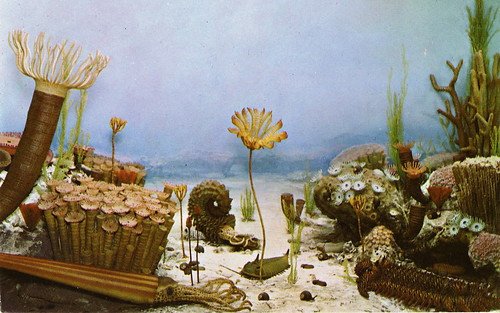
According to the Monterey Bay Aquarium Seafood Watch guide, bay scallops* and sea scallops are both generally fine choices in terms of sustainability and health. There are plenty of websites warning that "most scallops sold in the US" are treated with additives — specifically, with STP (sodium tripolyphosphate), which plumps them up and keeps them looking moist long after they would otherwise — but treated scallops are easy to spot and I haven't seen them sold that way in years. Then again, I live in the northeast, where both bay scallops and sea scallops are well-known and much appreciated. Let's have a brief tutorial, then, so you can take the appropriate course of action if you discover that a merchant in your area sells treated scallops: run them out of town, and agitate for them to be replaced with someone who cares about seafood.
The first tip-off that scallops have been treated with additives is if they're sitting in water. Both bay and sea scallops should be moist-looking and not the slightest bit dried out around the edges, but they should NOT be sitting in an inch or more of water. Or even half an inch. Aside from indicating that the scallops may have been treated with additives, a watery container means that a good portion of the price per pound would be, of course, water. Pan-seared scallops are good for dinner; pan-seared water, not so much.
The second (and equally-important) tip-off is the color of the scallops. Neither bay or sea scallops should be snowy white. They should be a creamy beige, or slightly pinkish, or tan, but never white. Look, I made you a visual aid:

The colors are a little washed-out thanks to my bargain-basement scanner, but you get the idea.
Scallops have a reputation for being somewhat expensive but both of my purchases were $14/pound, roughly the same price or lower than the most in-demand types of fish, and roughly the same price as the ones I see in grocery stores, and who knows where those are from? Also, there's almost no waste with scallops; 99% of the ones sold in the U.S., whether at farmers' markets, fishmongers or grocery stores, need only to have the tiny, chewy ligament attached to their side removed before they are ready to cook.
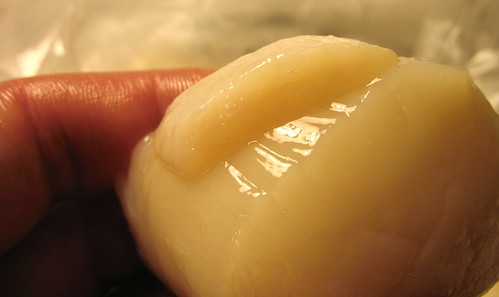
I ended up pan-searing both of my recent scallop purchases, but other than that the two meals were very different; the first featured a beurre blanc lightened by the addition of plenty of tart sliced sorrel, and in the second the scallops were given a Middle Eastern flavor with a garnish of the spice blend za'atar. Here are the recipes:
Scallops with sorrel beurre blanc
Serves 2-4.
This recipe is an adaptation of this one from Food & Wine. The fact that the original recipe calls for bay scallops necessitated a couple of rather obvious changes: sea scallops are larger and need to cook longer than bay scallops, and because of their size it is easier to cook them evenly if they are seared on each side rather than stirred around to cook on all sides. And because I would be searing my scallops and turning them only once, it would not do to add the sorrel to their pan, where it might interfere with the browning process; better to add it to the beurre blanc instead.
I was planning to otherwise follow the recipe, but at the very last minute I realized that not only did I not have Champagne vinegar, I didn't even have 1/2 cup of white wine vinegar remaining in the house. I did, however, have 1/4 cup, and I had enough Grüner Veltliner in the refrigerator to keep the Tiny Banquet household happy for at least a couple evenings, so I used a mixture of the two. The resulting sauce was deliciously well-balanced and I'd proudly serve it to anyone.
 A note on the portion sizes: Chef Vongerichten recommends 1 pound of bay scallops to serve 4. We had not eaten lunch and we ate an entire pound of sea scallops between the two of us. Obviously we are little piggies, although in our defense the rest of the meal consisted only of the fiddleheads I picked up at the greenmarket. If you are serving a first course you can certainly serve more than 2 people with these scallops. Unless they are hungry pigs.
A note on the portion sizes: Chef Vongerichten recommends 1 pound of bay scallops to serve 4. We had not eaten lunch and we ate an entire pound of sea scallops between the two of us. Obviously we are little piggies, although in our defense the rest of the meal consisted only of the fiddleheads I picked up at the greenmarket. If you are serving a first course you can certainly serve more than 2 people with these scallops. Unless they are hungry pigs.Don't be discouraged by the fact that you'll have to clarify some of the butter; it only takes a few moments, and as I've mentioned in the past, there are important reasons for using it.
3 to 4 tablespoons cold unsalted butter, cut into tablespoons, plus 1 to 2 tablespoons clarified butter
1 medium shallot, minced
fine sea salt and freshly ground pepper
1/4 cup white wine vinegar
1/4 cup good white wine, preferably Grüner Veltliner (or something similarly mineral and citrus-y in flavor)
1/4 cup heavy cream
a pinch of cayenne pepper
1 pound sea scallops, tough ligament removed
1/2 cup tightly packed sorrel leaves, tough stems removed and finely shredded
Melt 1 tablespoon of the butter in a medium-sized skillet or shallow sauce pan over moderate heat. Add the shallot, season it lightly with salt and pepper, and cook, stirring, until it just begins to brown, about 1 minute. Add the vinegar and the white wine and cook, swirling the skillet over the heat, until the liquid is reduced to a couple tablespoons. Add the cream and bring it just to a boil. Add the remaining 2 to 3 tablespoons of butter, one piece at a time, while stirring the mixture with a wooden spoon; the sauce will thicken. (It will taste best if you add 3 tablespoons of butter, but if the thought horrifies you, you can get away with only adding 2). Stir in half of the sorrel and season the sauce to taste with the cayenne pepper and a bit more salt if necessary.
Meanwhile, heat the clarified butter in a heavy skillet (preferably cast iron) over moderately high heat. Add the scallops in one layer and cook approximately 10 minutes per inch of thickness, flipping them once during the middle of cooking. (It will be easiest to turn them if they are not crowded too closely together in the pan). Transfer the scallops to plates, spoon the sauce over them, garnish them with the remaining sorrel, and serve at once.
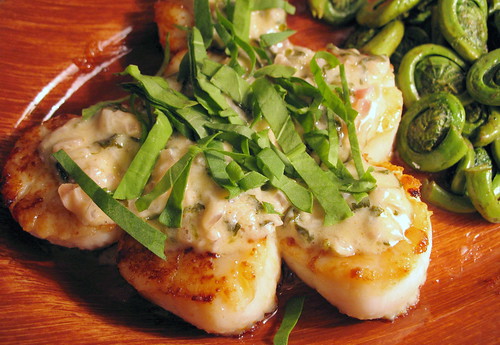
The other recipe is very different but no less delicious. I first discovered the spice blend za'atar a few years ago in my beloved copy of Madhur Jaffrey's World Vegetarian; I'm not sure what drew my attention to such a brief recipe in such a big book, but somehow I decided I had to try it, and I fell in love with the flavor. There's a similar recipe for it in Claudia Roden's New Book of Middle Eastern Food because, unlike other Middle Eastern spice blends, za'atar (sometimes spelled zaatar or zahtar) is simple: it's only got four ingredients, maybe just three if you want it unsalted. According to Roden, za'atar is "wild thyme. It is also the name of the mixture of this herb with sumac, salt, and toasted sesame seeds. The mix, which is popular in Syria, Lebanon, Israel, and Jordan, is sold in little paper cornets to dip into with bread." It's great on all sorts of other foods, though; sumac is made of ground tart, red berries and like lemon, it brightens every dish it goes into. In colder weather I particularly like za'atar on roasted sweet potatoes. Now I know I love it on scallops, too.


Any decent spice store will sell a pre-mixed version made with dried thyme, but it only takes a couple minutes to make your own with fresh thyme and the result is much more flavorful than any blend commercially available here.
Seared sea scallops with za'atar
Serves 2-4 (see comments above regarding portion size).
This recipe makes more za'atar than you'll need but it's not practical to make a smaller quantity, and it will keep well for a few days in a tightly-sealed container.
1 rounded tablespoon thyme, leaves only
2 rounded teaspoons sumac
2 rounded teaspoons toasted sesame seeds
coarse salt, to taste
1 to 2 tablespoons clarified butter
1 pound sea scallops, tough ligaments removed
Stir the first four ingredients together in a small bowl and set aside.
Heat the clarified butter in a heavy skillet (preferably cast iron) over moderately high heat. Add the scallops in one layer and cook approximately 10 minutes per inch of thickness, flipping them once during the middle of cooking. (It will be easiest to turn them if they are not crowded too closely together in the pan). Transfer the scallops to plates and sprinkle them generously with the za'atar. Serve at once.

* I don't see bay scallops around Manhattan often, but if you have an opportunity to buy them there is no reason to be snobbish about their comparatively diminutive size; some people prefer their flavor over sea scallops, believing them to be slightly sweeter.


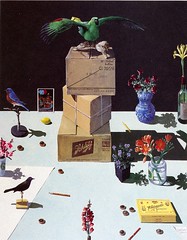

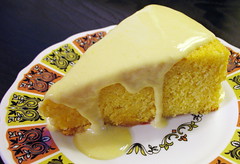
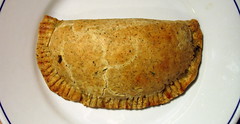


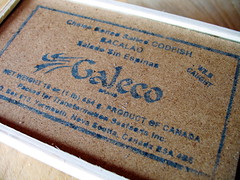

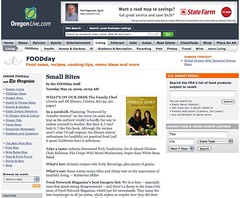



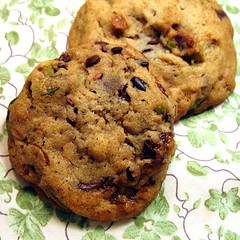

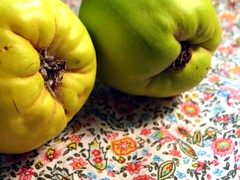
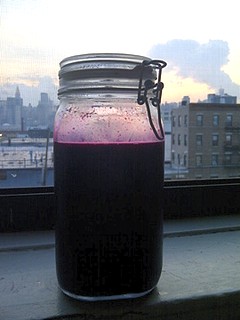
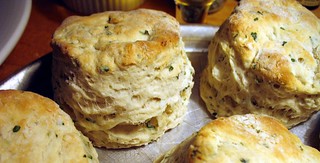
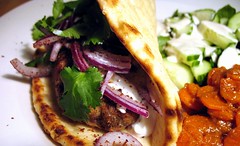
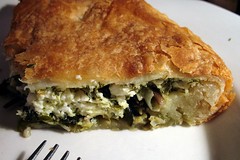


wow, I literally just drooled on my keyboard. za'taar flavored scallops? That sounds awesome!
ReplyDeleteI wish scallops in the U.S. came with the coral still attached. I have no idea what it tastes like, but all those Brit cooks/chefs on tv seem to enjoy the heck out of it, and it's pretty to boot. *sigh*
Ann, I wish we got the coral too. And the shells, to use as little dishes. I wonder if our scallops are sold as they are because Americans tend to be squeamish about things, or is it because of pricing issues or . . . ?
ReplyDeleteLove the idea of using paint cards to talk about food colors. So smart, funny too.
ReplyDeleteThanks Chris - I have a ridiculously comprehensive collection of them after painting and re-painting and re-painting yet again some bookcases in my apt. - I can't part with them because I love the silly names for the colors.
ReplyDeleteLovely post! I'm checking online to see if I got fleeced at the fish market because of those red dangly bits on my fresh scallops! (Were they just to add weight?!) (WHEW! So glad they're going to be tasty!) I'm a Canadian in Ireland, and I have no idea what to do with the coral. I'm going to choose the tastiest looking recipe I can find...they seem to use the roe in Australia too? Thanks for your blog! :-)
ReplyDeleteThanks Heather! The English use the roe too so it might be worthwhile to poke around the BBC food section or the Guardian's recipes. I found this one on the BBC site but I'm sure there's more:
ReplyDeletehttp://www.bbc.co.uk/food/recipes/database/scallopnagewithbabyv_88575.shtml
hm, I don't know if that link will work so try this one:
ReplyDeleterecipe